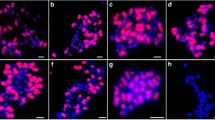Abstract
Moso bamboo (Phyllostachys pubescens) is one of the world’s most important bamboo species. It has the largest area of all planted bamboo—over two-thirds of the total bamboo forest area—and the highest economic value in China. Moso bamboo is a tetraploid (4x=48) and a special member of the grasses family. Although several genomes have been sequenced or are being sequenced in the grasses family, we know little about the genome of the bambusoids (bamboos). In this study, the moso bamboo genome size was estimated to be about 2034 Mb by flow cytometry (FCM), using maize (cv. B73) and rice (cv. Nipponbare) as internal references. The rice genome has been sequenced and the maize genome is being sequenced. We found that the size of the moso bamboo genome was similar to that of maize but significantly larger than that of rice. To determine whether the bamboo genome had a high proportion of repeat elements, similar to that of the maize genome, approximately 1000 genome survey sequences (GSS) were generated. Sequence analysis showed that the proportion of repeat elements was 23.3% for the bamboo genome, which is significantly lower than that of the maize genome (65.7%). The bamboo repeat elements were mainly Gypsy/DIRS1 and Ty1/Copia LTR retrotransposons (14.7%), with a few DNA transposons. However, more genomic sequences are needed to confirm the above results due to several factors, such as the limitation of our GSS data. This study is the first to investigate sequence composition of the bamboo genome. Our results are valuable for future genome research of moso and other bamboos.
Similar content being viewed by others
References
Jiang Z H. World Bamboo and Rattan (in Chinese). Shengyang: Liaoning Science and Technology Publishing House, 2002
GPWG (Grass Phylogeny Working Group). Phylogeny and subfamilial classification of the grasses (Poaceae). Ann Missouri Bot Garden, 2001, 88(3): 373–457
Li X L, Liu S, Song W Q, et al. Chromosome number of forty species of scattered bamboos. Acta Phytotaxonomica Sin (in Chinese), 1999, 37(6): 541–544
Mathews S, Tsai R C, Kellogg E A. Phylogenetic structure in the grass family (Poaceae): Evidence from the nuclear gene phytochrome B. Am J Bot, 2000, 87(1): 96–107
Guo Z H, Li D Z. Phylogenetics of the Thamnocalamus group and its allies (Gramineae: Bambusoideae): Inference from the sequences of GBSSI gene and ITS spacer. Mol Phylogenet Evol, 2004, 30(1): 1–12
SanMiguel P, Tikhonov A, Jin Y K, et al. Nested retrotransposons in the intergenic regions of the maize genome. Science, 1996, 274(5288): 765–768
Song R, Llaca V, Messing J. Mosaic organization of orthologous sequences in grass genomes. Genome Res, 2002, 12(10): 1549–1555
Gielis J, Valente P, Bridts C, et al. Estimation of DNA content of bamboos using flow cytometry and confocal laser scanning microscopy. The Bamboos. London: Academic Press, 1997. 215–223
Paterson A H, Freeling M, Sasaki T. Grains of knowledge: Genomics of model cereals. Genome Res, 2005, 15(12): 1643–1650
Otto F J. DAPI staining of fixed cells for high-resolution flow cytometry of nuclear DNA. In: Darzynkiewickz Z, Crissman H A, eds. Methods in Cell Biology. Vol 33. San Diego: Academic Press, 1990. 105–110
Wang G L, Fang H J. Plant Gene Engineering (in Chinese). 2nd ed. Beijing: Science Press, 2002. 744
Messing J, Bharti A K, Karlowski W M, et al. Sequence composition and genome organization of maize. Proc Natl Acad Sci USA, 2004, 101(40): 14349–14354
Jurka J. Repbase update: A database and an electronic journal of repetitive elements. Trends Genet, 2000, 16(9): 418–420
Ouyang S, Buell C R. The TIGR Plant Repeat Databases: A collective resource for the identification of repetitive sequences in plants. Nucleic Acids Res, 2004, 32 (Database issue): 360–363
Altschul S F, Madden T L, Schaffer A A, et al. Gapped BLAST and PSI-BLAST: A new generation of protein database search programs. Nucleic Acids Res, 1997, 25(17): 3389–3402
Rayburn A L, Biradar D P, Bullock D G, et al. Nuclear DNA content in F sub(1) hybrids of maize. Heredity, 1993, 70(3): 294–300
Bennett M D, Smith J B. Nuclear DNA amounts in angiosperms. Phils Trans R Soc Lond B Biol Sci, 1976, 274(933): 227–274
International Rice Genome Sequencing Project. The map-based sequence of the rice genome. Nature, 2005, 436(7052): 793–800
Martinez C P, Arumuganathan K, Kikuchi H, et al. Estimation of nuclear DNA content in Oryza by flow cytometry. Rice Genet Newslett, 1993, 10: 116–119
Haberer G, Young S, Bharti A K, et al. Structure and architecture of the maize genome. Plant Physiol, 2005, 139(4): 1612–1624
Bedell J A, Budiman M A, Nunberg A, et al. Sorghum genome sequencing by methylation filtration. PLoS Biol, 2005, 3(1): e13
Tiersch T R, Chandler R W, Wachtel S S, et al. Reference standards for flow cytometry and application in comparative studies of nuclear DNA content. Cytometry, 1989, 10: 706–710
Johnston J P, Bennett M D, Rayburn A L, et al. Reference standards for determination of DNA content of plant nuclei. Am J Bot, 1999, 86(5): 609–613
Arabidopsis Genome Initiative. Analysis of the genome sequence of the flowering plant Arabidopsis thaliana. Nature, 2000, 408(6814): 796–815
Author information
Authors and Affiliations
Corresponding author
Additional information
Supported by the Program for New Century Excellent Talents in University of China
Rights and permissions
About this article
Cite this article
Gui, Y., Wang, S., Quan, L. et al. Genome size and sequence composition of moso bamboo: A comparative study. SCI CHINA SER C 50, 700–705 (2007). https://doi.org/10.1007/s11427-007-0081-6
Received:
Accepted:
Issue Date:
DOI: https://doi.org/10.1007/s11427-007-0081-6




